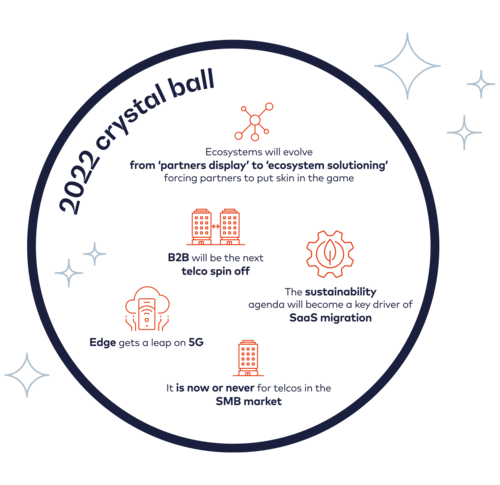
Undoubtedly, 2021 was the year in which building a partner ecosystem became mainstream. The issue, however, is that many of the partner offers are little more than eye-candy on an eCommerce or AppStore, resulting in very limited real value being added – for customers, resellers or partners – resulting in low adoption rates by Enterprises and SMBs.
In 2022, there will be a turning point. More players will start to mature their ecosystem strategies. They will realize that to create real customer value leveraging a partner ecosystem, they first need a deep understanding of their customers’ needs, and then to more selectively build more strategic relationships with partners with complementary capabilities that can help them co-create solutions that perfectly solve their customer needs.

We’re already seeing the first signs of this evolution with Nokia partnering with AWS to enable cloud-based 5G radio solutions and Google Cloud and Ericsson coming together to help CSPs deliver capabilities to the edge.
During the last two years, many telcos announced plans to spin off either network towers or fiber infrastructure, usually to reduce debt. 2021 also saw telcos announce plans to redefine their mission to capitalize on the opportunity to restructure into technology communications or “techco”. Vodafone said it would be splitting its IT and networks to focus on its techco vision while BT brought in new leadership to spearhead its new digital business unit. Nearly 70% of operating CEOs view B2B as the incremental opportunity enabling them to monetize their 5G investment, but we are only at the very start of this journey.
The challenge is that very traditional CSPs are largely consumer centric and their business models and ways of working aren’t suited to the demands of B2B reflected in the limited success so far in this sector. 2022 will see CSPs restructure further to best attack the B2B opportunity and the need to form far deeper customer relationships, understand customer problems within major industry verticals and co-create solutions with ecosystem partners.
CSPs forming techco will attract new investors, but they will never achieve their full potential in terms of market valuations unless they are decoupled further from the mass consumer business which dominates the think space at executive level. Support from investors will help CSPs surmount internal battles for resources to invest in an innovative solution portfolio that combine new technology with 5G and edge to solve real customer problems. In strategic terms, techco provide a pathway to the CSP to improve PE ratios and stock market valuations as they capitalize upon a rapidly growing market in SMB and enterprise for advanced technology solutions that facilitate digital growth and transformation.
Telcos have invested a lot of time in trying to define killer use cases for 5G, but the market for it is evolving more slowly and there isn’t yet the demand. Conversely the use cases for Mobile Edge Compute (MEC or “Edge”) are more mature and will work with most connectivity including fiber and 4G. Consequently, there is immediate value to be realized in 2022 and so CSPs will switch priority to monetizing Edge use cases and put 5G on a slower development path. In fact, Gartner forecasted that by year-end 2023, more than 50% of large enterprises will deploy at least six Edge computing uses cases.
The how, when, and why to use the Edge is much clearer and the focus is sharper. Enterprises understand the benefits they can achieve in the latency reductions achieved by moving their compute to the edge. In fact, they see that in doing so they don’t need the speed of 5G and many of the applications they envisage as supporting their digital transformation ambitions, productivity and efficiency enhancements can be achieved through a combination of edge architectures and 4G networks. Even capabilities such as network slicing are now wholly achievable on 4G to support those solutions and services that require more dynamic, dedicated connectivity.
The carbon footprint of our gadgets, the internet and the systems supporting them account for about 3.7% of global greenhouse emissions, according to ClimateCare. Although the ICT sector is making significant progress in decarbonizing and provides powerful technology that enables other sectors to become more energy efficient – Google's new cloud computing tool for example helps its customers to pick cloud regions that have a lower carbon footprint while Microsoft just opened a new data center region in Sweden that runs entirely on green energy and supports zero-waste operations — these emissions are predicted to double by 2025. More must be done.
With enterprises increasingly expected – by their customers, partners and government – to follow standards such as the Greenhouse Gas Protocol and report on their emissions, CIOs have a more significant role to play. In 2022, we expect sustainability to become a key driver for cloud migration and be part of CIOs’ decision to make the switch to SaaS.
The pandemic had a lasting effect on all businesses, and in particular, the SMB market is one sector that is focused on accelerating its digital transformation journey to aid its recovery. The SMB and large enterprise sectors are spending most on digital transformation and there is real hunger for moving services online and taking costs out of efficiencies. SMB has long been coveted by CSPs and is now as attractive an opportunity as ever as SMBs look to embrace new digital tools. But SMB demand has not only attracted attention from CSPs, but from alternative service providers like large technology companies, hyperscalers and even financials too, all lining up to deliver technology-based solutions and platforms that cater specifically to the needs of the SMB market. After years of having to go to multiple providers for their ICT needs, 2022 will be the year that someone takes on the role of the SMB saviour. If CSPs are to step up to that plate, then they must meet with demand for technology solutions that are simple to integrate and reduce the complexity of needing to understand a variety of technologies. This will see greater dependency on ecosystem collaboration and the co-creation of solutions through alignment of joint specialisms across partners and investors with skin in the game.
This article first appeared in The Fast Mode
